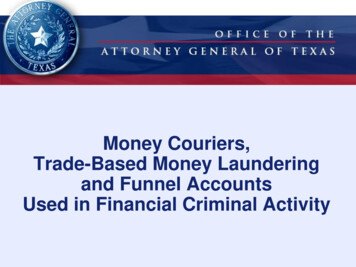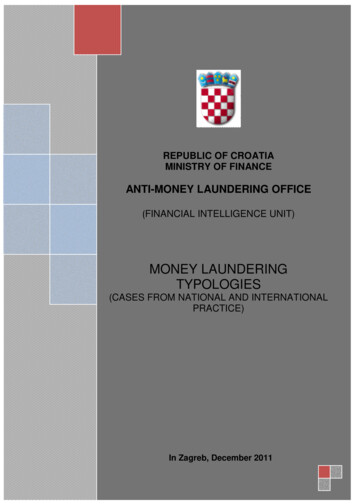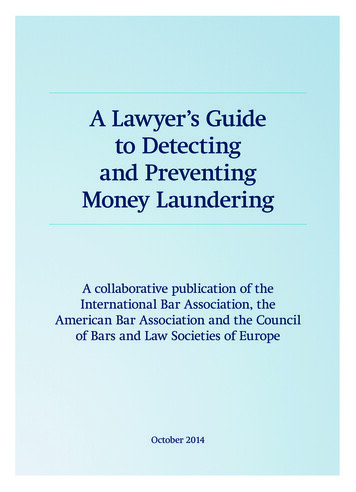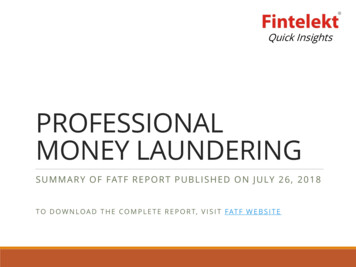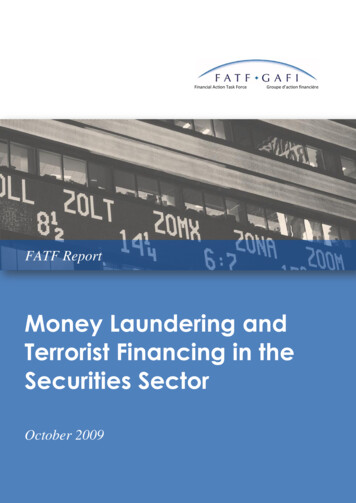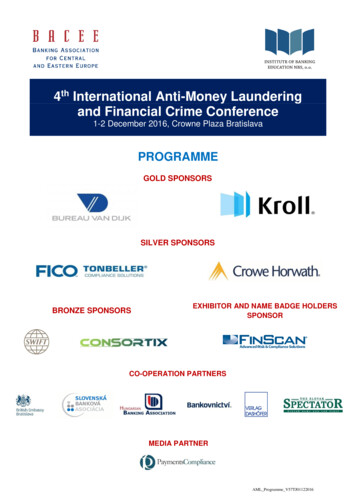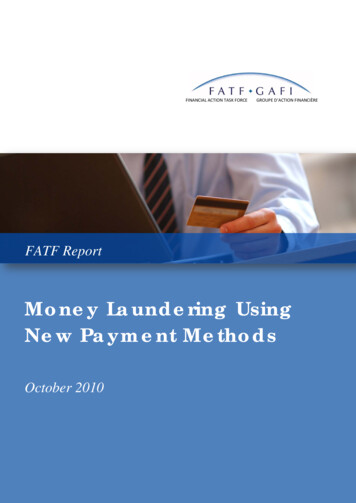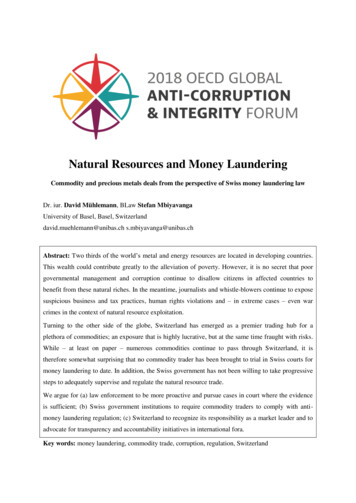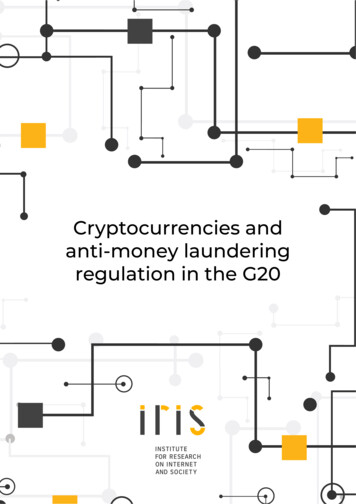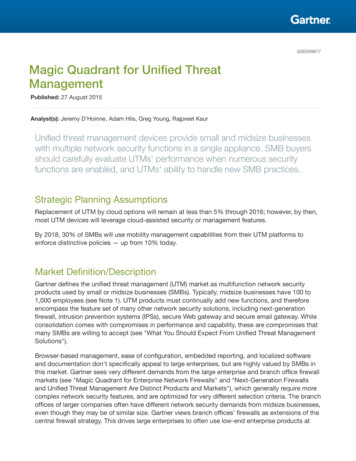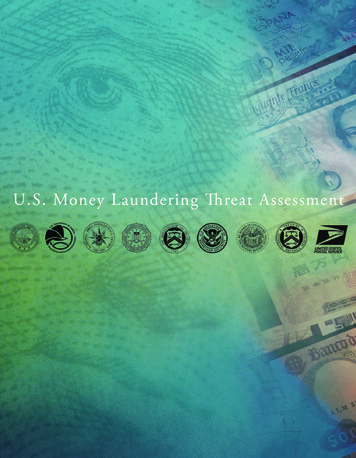
Transcription
MONEY LAUNDERING THREAT ASSESSMENTW O R K I N GG R O U PDepartment of the TreasuryOffice of Terrorism and Financial Intelligence (TFI) Office of Terrorist Financing & Financial Crime (TFFC)Financial Crimes Enforcement Network (FinCEN)Office of Intelligence and Analysis (OIA)Office of Foreign Assets Control (OFAC)Executive Office for Asset Forfeiture (TEOAF)Internal Revenue Service (IRS) Criminal Investigation (CI) Small Business/Self Employed Division (SB/SE)Department of JusticeFederal Bureau of Investigation (FBI)Drug Enforcement Administration (DEA)Criminal Division Asset Forfeiture Money Laundering Section (AFMLS)National Drug Intelligence Center (NDIC)Organized Crime Drug Enforcement Task Force (OCDETF)Department of Homeland SecurityImmigration and Customs Enforcement (ICE)Customs and Border Protection (CBP)Board of Governors of the Federal Reserve SystemUnited States Postal Service (USPS)United States Postal Inspection Service (USPIS)
U. S. Money Laundering Threat AssessmentDecember 2005
TABLE OF CONTENTSM O N E YL A U N D E R I N GT H R E A TA S S E S S M E N TIntroduction. iBanking. 1Money Services Businesses. 7Money Transmitters. 11Check Cashers. 14Currency Exchangers. 15Money Orders. . 17Stored Value Cards. 20Online Payment Systems. 25Informal Value Transfer Systems. . 29Bulk Cash Smuggling. 33Trade-Based Money Laundering. 41Insurance Companies. 45Shell Companies And Trusts. 47Casinos. . 51Appendices(A) NDIC Analysis. . 57(B) FinCEN Analysis. 59(C) Bank Secrecy Act Reports. 69(D) Status of BSA Regulations for Financial Institutions. 71
INTRODUCTIONIntroductionThe 2005 Money Laundering Threat Assessment(MLTA) is the first government-wide analysis ofmoney laundering in the United States. The report isthe product of an interagency working group composedof experts from the spectrum of U.S. Government agencies, bureaus, and offices that study and combat moneylaundering. The purpose of the MLTA is to help policymakers, regulators, and the law enforcement communitybetter understand the landscape of money laundering inthe United States and to support strategic planning efforts to combat money laundering.The working group synthesized law enforcement statistics and observations, regulatory data (such as BankSecrecy Act filings), private sector studies, and publicinformation to assess the vulnerabilities that allow criminals to launder money through particular money laundering methods or conduits.The MLTA offers a detailed analysis of thirteen moneylaundering methods, ranging from well-established techniques for integrating dirty money into the financial system to modern innovations that exploit global paymentnetworks as well as the Internet. Each chapter focuseson a specific money laundering method and provides abrief overview of the methodology, an assessment ofvulnerabilities – including geographic or other notedconcentrations – and the regulatory/public policy backdrop.While not exhaustive, the assessment consolidates a tremendous amount of information and insight contributedby the various participating agencies as to the majormethods of money laundering that they confront. Theoverall picture is both sobering and promising. Thevolume of dirty money circulating through the UnitedStates is undeniably vast and criminals are enjoyingnew advantages with globalization and the advent ofnew financial services such as stored value cards andonline payment systems. At the same time, there hasbeen considerable progress. The approach of U.S. lawenforcement and regulatory agencies has undergone asea change over the past decade, such that money laundering is now treated as an independent and primary focus across all relevant agencies. With this change inapproach and focus have come marked improvementsin both systemic and applied anti-money laundering(AML) efforts. Most encouraging are interagency initiatives and task forces that, when properly coordinated,bring the talents, expertise, and resources of multipleagencies to bear on a problem to great effect. With somany agencies looking at distinct but related aspects ofthis issue, it is critical that information be shared freelyand studied jointly. Highlighted below are some notableexamples of recent U.S. agency advances in organization, analysis, and execution in the fight against moneylaundering:U.S. Immigration and Customs Enforcement (ICE), hasintroduced many new initiatives aimed at analyzing andcombating the movement of illicit funds by bulk cashsmuggling, trade-based money laundering, courier hubs,money services businesses (MSBs), charities, and alternative remittance systems. These initiatives include: Operation Cornerstone, founded in 2003 – a privateindustry partnership and aggressive outreachprogram;A Trade Transparency Unit (TTU) aimed atidentifying anomalies related to cross-border tradeindicative of money laundering;A multi-agency approach (in partnership withInternal Revenue Service – Criminal Investigation(IRS-CI), FinCEN, and the Federal Bureau ofInvestigation (FBI)) to target unlicensed MSBs;andA Foreign Political Corruption Task Force inMiami to address foreign public corruption andrelated money laundering.With respect to bulk cash smuggling in particular, ICEis: Working with Customs and Border Protection (CBP)to share training and expertise with the Mexicangovernment as to how to execute successful bulkcash smuggling interdiction operations;Providing training in bulk cash smugglinginterdiction to 28 developing countries in theMiddle East, South America, Africa, and Asia, inconcert with CBP and the State Department; andINTRODUCTION
INTRODUCTION Conducting training in bulk cash smugglinginterdiction, funded by the Executive Office forOrganized Crime Drug Enforcement Task Forces(OCDETF), in seven major cities throughout theUnited States, attended by federal, state and locallaw enforcement.The FBI is working to develop advanced technologiesto exploit Suspicious Activity Reports (SARs) and otherBank Secrecy Act (BSA) data from FinCEN by usingcomputer software to visualize financial patterns, linkdistinct criminal activities, and display the activity inlink analysis charts. The FBI is also implementing anext-generation electronic file management system thatwill help manage investigative, administrative, and intelligence needs while also improving ways to encourage information sharing with other agencies.The Administrator of the Drug Enforcement Administration (DEA) issued a directive in 2003 restoring DEA’sprimary focus to the financial aspects of drug investigations. Currently, every DEA investigation includes a financial component. DEA also undertook the followingsteps to promote this focus: Established an Office of Financial Operations;Established specialized money laundering groupsin every DEA Field Division, and increased SpecialAgent resources devoted to money launderinginvstigations in key foreign offices;Created and presented specialized moneylaundering training to DEA agents and analysts;Established a “Bulk Currency Initiative” tocoordinate all U.S. highway money seizures forthe purpose of developing the evidence necessaryto identify, disrupt, and dismantle large-scalenarcotics trafficking organizations; andInitiated a global money flow study, throughits position as chair of the International DrugEnforcement Conference, to identify and targetdrug proceeds flowing from countries of drugabuse to countries of drug supply.The IRS, as part of its core tax administration mission,addresses both the criminal and civil aspects of moneylaundering. IRS-CI special agents “follow the money”iiINTRODUCTIONwithin various inter-agency task forces and centers.IRS-CI also has 41 active Suspicious Activity ReportReview Teams (SAR-RT) reviewing and analyzingSAR data for case development and support throughoutthe country. Recently-acquired “data mining” softwareis improving the ability of IRS-CI’s investigators andanalysts to make connections and identify patterns in theSAR data.On the civil side, the IRS established a new organizationwithin its Small Business/Self-employed (SB/SE) Division, the Office of Fraud/BSA, which has end-to-endaccountability for BSA oversight of certain non-bankfinancial institutions. There are over 300 examinersand managers who are fully trained and dedicated fulltime to the BSA program. The IRS has also completeda model Federal/State Memorandum of Understandingwhich provides both IRS and the participating state theopportunity to leverage resources for BSA examinations, outreach, and training.Treasury’s Office of Terrorist Financing and FinancialCrime (TFFC), a part of the Office of Terrorism andFinancial Intelligence, is working to develop and driveanti-money laundering policy and initiatives at homeand abroad. A primary initiative of this office is to leadthe interagency development of the National MoneyLaundering Strategy. In crafting this and other strategies, TFFC works with the law enforcement, regulatory,and intelligence communities, in addition to the privatesector and overseas counterparts, to identify and addresssystemic vulnerabilities. In addition, TFFC, along withinter-agency counterparts, has been a driving force behind the worldwide propagation of strong anti-moneylaundering standards via the Financial Action Task Force(FATF), the preeminent international body on moneylaundering issues. Over the past two years, scores ofnew countries – from North Africa to the Persian Gulfregion to Eurasia – have joined FATF-style regionalbodies, such that over 150 nations have now committedthemselves to adopting FATF’s standards and to beingevaluated against them.The BSA, administered by the Treasury Department’sFinancial Crimes Enforcement Network (FinCEN), isthe cornerstone of the U.S. Government’s AML framework and was recently expanded in scope and depth.Today, businesses under the BSA umbrella include casinos, jewelers, MSBs (such as check cashers and money
INTRODUCTIONtransmitters), securities dealers, and others.FinCEN is itself undergoing a broad transformation.The bureau is changing the way it analyzes information,moving away from functioning simply as a clearinghouse, and moving towards higher-level research andanalysis, which will utilize all sources of information toanalyze the cutting-edge systems of money launderingand illicit finance. FinCEN has also signed memorandaof understanding with the federal regulatory agenciesthat have received delegated authority from FinCEN toexamine financial institutions for compliance with theBSA. The goal is better coordination and communication leading to effective implementation and enforcementof the BSA, which ultimately should help to achieve asustained and successful attack on money laundering inthe United States.The U.S. Postal Inspection Service (USPIS) enjoys theadvantage of having more than 100,000 postal clerksand managers on the alert for possible suspicious activity. These employees file over 500 SARs per week tothe U.S. Postal Service (USPS) BSA Compliance Office. USPIS recently established an Intelligence Analysis Unit (IAU) at its headquarters office to ensure thatthese reports as well as back room analysis are beingutilized effectively. The IAU methodically analyzes theUSPS BSA database, searching for clues that might indicate major money laundering operations and possibleterrorist financing schemes. The IAU both responds toinvestigative inquiries from field inspectors and proactively initiates investigative leads for the field.The Department of Justice’s Asset Forfeiture and MoneyLaundering Section (AFMLS) reports that the USA PATRIOT Act provided a number of new tools to identifyand track criminal proceeds. Section 319(a) has been ofparticular importance, allowing the government to capture criminal assets held abroad if the criminal proceedsare deposited in a foreign bank that maintains a correspondent account in the United States. The Civil AssetReform Act of 2000 is another important tool assistingfederal law enforcement in making asset forfeitures. Thelaw makes possible both the criminal and civil forfeiture of the proceeds of all specified unlawful activities.Many U.S. Attorney’s Offices will not approve an indict-1ment for presentation to the grand jury until a forfeiturespecialist has reviewed it for possible criminal forfeitureand/or the filing of a parallel civil forfeiture complaint.In 2005, the Departments of Justice, HomelandSecurity,1 and Treasury established a multi-agency drugand financial intelligence fusion center through the OCDETF program. Leads resulting from the efforts of theFusion Center will support the initiation and development of coordinated international, national, and regionalinvestigations. AFMLS, in partnership with OCDETF,has conducted Financial Investigation Training Seminars in every OCDETF region in the country during thepast two years.The National Drug Intelligence Center (NDIC), whosemission is to develop strategic domestic drug intelligence, created a Money Laundering Unit in January2005 to provide a multi-source fusion capability formoney laundering-related information. The mission ofthis unit is to identify strategic money laundering trendsand patterns for national policy makers.The Treasury Executive Office for Asset Forfeiture(TEOAF) administers the Treasury Forfeiture Fund, andhas implemented a strategic focus on promoting “highimpact cases,” or cases that generate 100,000 or morein forfeited value. In FY 2004, the Fund received morethan 335 million in revenue, 84% of which was derivedfrom “high impact cases.” TEOAF then uses this moneyto fund law enforcement training, special programs, andcriminal investigations. Legal, structural, and strategic advances improve theability of U.S. agencies to track and combat money launderers. That said, money laundering remains a massiveand evolving challenge that will require clear, strategicthinking. Measuring the problem is an essential firststep. Studies have traditionally looked to that portionof illicit activity that is apprehended by authorities asan indicator of the types of money laundering goingon and trends within the field. Such indicators includeseized or forfeited assets, indictments, and BSA filingsThe United States Coast Guard.INTRODUCTIONiii
INTRODUCTIONby financial institutions, such as SARs. Each of theseis admittedly imperfect, but could offer much useful information.Unfortunately, however, the data are not as developedas they should be and not collected in a systematic wayacross the U.S. government. It is currently not possible,for example, to quantify with accuracy the total amountof money laundering activity being apprehended byfederal law enforcement agencies, let alone state andlocal law enforcement. Individual tracking systems developed and tailored to meet particular agency priorities and needs have yielded often incompatible systems.Problems include data fields that are collected by somebut not all agencies, disparities in definitions, and redundancies wherein two or more agencies log the sameseizure or arrest because the case was handled througha joint task force. Agencies may not even share common definitions of what constitutes “money launderingproceeds,” or what nexus to the United States warrantsdefining illicit activity as “United States” money laundering.Appendices to this assessment make the most of the existing data to offer a rough quantitative analysis of money laundering concentrations. Going forward, though,more data needs to be collected in a more consistent wayacross agencies. Of particular importance is information that would track, with respect to every money laundering seizure, the following: (1) the predicate crime,(2) the money laundering method/s utilized, and (3) thesource and suspected destination of the proceeds. Accurate, comprehensive data is vitally important if we areto assess whether we are collectively gaining ground,keeping pace, or falling behind criminal money launderers in each of the various methodologies that they employ.ivINTRODUCTION
BANKINGChapter 1BankingBanks and other depository financial institutionsin the United States are unique in that they aloneare allowed to engage in the business of receiving deposits and providing direct access to those depositsthrough the payments system. The payments system encompasses paper checks and various electronic paymentnetworks facilitating credit and debit cards and bank-tobank transfers. The unique role banks play makes themthe first line of defense against money laundering.Depository financial institutions (DFIs), which includecommercial banks, savings and loan associations (alsocalled thrifts), and credit unions form the financial backbone of the United States.2 Although Money ServiceBusinesses (MSBs) may offer an alternative to banks,MSBs must themselves engage the services of a DFI tohold deposits, clear checks, and settle transactions. Thusin almost every money laundering typology, a bank isemployed domestically or abroad to hold or move funds.The stage at which funds are introduced into the banking system is a critical one. A report from the New YorkClearing House, which operates bank payment systems,acknowledges: “Once a person is able to inject fundsinto the payment system that are a product of a criminalact or are intended to finance a criminal act, it is highlydifficult, and in many cases impossible, to identify thosefunds as they move from bank to bank.”3The BSA requires banks to establish and maintain effective anti-money laundering (AML) programs, implement customer identification programs, and maintaintransaction records. Banks also are obligated to reportcash transactions exceeding 10,000 as well as transactions that appear suspicious.Banks are ubiquitous in the United States but industryconsolidation, due to deregulation and competitive pres-CHAPTER 1sures, is reducing the number of distinct DFIs. At yearend in 2004 there wer
examples of recent U.S. agency advances in organiza-tion, analysis, and execution in the fight against money laundering: U.S. Immigration and Customs Enforcement (ICE), has introduced many new initiatives aimed at analyzing and combating the movement of illicit funds by bulk ca
